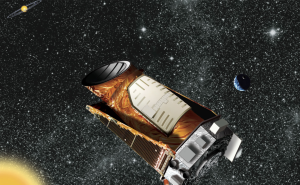In the search for Earth-size planets elsewhere in the Milky Way, lower-mass stars make for more promising hunting grounds, UA astronomers have discovered.
By Daniel Stolte, University Relations – Communication | February 17, 2015
In the search for Earth-size planets, lower-mass stars make for more promising hunting grounds than their sun-like counterparts, a team of University of Arizona astronomers has discovered.
Stars weighing in at less than half of the sun’s mass are twice as likely to possess planets and these planets can be found closer to their host stars, the research team reports in the Astrophysical Journal. The study suggests that scientists looking for planets outside of our solar system — called exoplanets — are more likely to discover Earth-size planets by focusing their search on such lower-mass stars, also known as red dwarfs.
“When you combine the fact that red dwarfs vastly outnumber the sunlike stars in the Milky Way with our finding that those stars have more planets, you realize that most planets waiting to be discovered are going to be found around lower-mass stars,” said Gijs Mulders, the lead author of the study. Mulders is a postdoctoral fellow in the UA’s Department of Planetary Sciences and Lunar and Planetary Laboratory.
“It seems that lower-mass stars are more efficient at making planets, and we really would like to know why,” he added.
The findings were made by systematically analyzing data gathered by the Kepler Space Telescope. Launched in March 2009, Kepler is a space observatory launched by NASA to discover Earth-like planets orbiting other stars. The telescope did this by staring into one small patch of sky for the duration of its first mission, monitoring more than 100,000 stars for tiny dips in light called transits, caused when planets pass in front of them.
“For sun-like stars, we have detected thousands of planetary candidates with Kepler, but less than a hundred for red dwarfs of which fewer have been observed,” Mulders said. “We wanted to know: Does it matter around what type of star a planet forms? Apparently it does, and that has implications for detecting Earth-size planets.”
Mulders collaborated with Ilaria Pascucci, professor at LPL, and Daniel Apai, professor at the UA’s Department of Astronomy and Steward Observatory and LPL. The team took the available data from the candidate planetary systems discovered by Kepler in the first two years and calculated the average number per star through statistical reconstructions. This is a necessary step, as not all planets transit their hosts’ stars: Planets farther from their hosts’ stars have a lower probability to be detected, while it is easier to discover small planets around smaller stars as they cover a relatively larger part of their surface. Only after this step, the researchers were able to compare the likelihoods of having planets for stars of different sizes and found them to be different.
“Basically, we inferred the number of planets that exist from the small subset observed by Kepler,” Mulders said.

Previous studies had found that lower-mass stars had more planets, but only for a small size range (two to four earth radii) and therefore excluded Earth-size planets.
“By including more stars over a much longer observation period, we were able to expand that population by including planets ranging in size from one to four Earth radii,” Mulders explained. “In other words, planets whose size is somewhere between Earth and Neptune.”
Most of the Kepler systems are very different from our solar system, with the majority of planets discovered occupying very tight orbits around their stars. These so-called super-Earths or mini-Neptunes are often much bigger than Earth, and their orbits range from closer than Mercury’s orbit around the sun, to almost as far as Earth’s orbit.
Earth-like planets, on the other hand, are expected to be restricted to the habitable zone, where temperatures allow for liquid water to occur.
“Finding Earth-size planets in the habitable zone is easier around a lower-mass star,” Apai said, “and because the star is smaller, the habitable zone of where planets cool enough to sustain life could exist extends closer to the star.”
Unlike previous studies, which had lumped together different distances between planet and host star, the new research applied the calculations for planets at different distances from the star, showing that planets have tighter orbits around lower-mass stars. This finding allowed Mulders and his colleagues to draw implications for theories on how planets are born.
“Planets form in protoplanetary disks consisting of gas and dust, and those have an inner dust edge that was thought to correspond with the orbit of the innermost planet,” said Pascucci, co-author of the study. “But to our surprise, the idea that planets form in place doesn’t match our findings.”
Observations show that while the gas disk extends close to the star, the dust portion of the protoplanetary disk is limited to a certain distance from the star because dust grains evaporate once temperatures become too hot. Compared to sun-like stars, the dust disk around a red dwarf reaches much closer to the star, with the gas disk’s edge being closer, too, but not by as much.
“The tighter planet orbits around red dwarfs match the location of the gas, which implies that those planets or their building blocks must have formed from dust further out in the disk and then migrated inward,” Pascucci said.
Over the course of its second mission, which began in May 2014, the Kepler telescope will peer out into the galaxy at various fields of view.
“Kepler is now looking at stars of even lower masses than before,” Mulders said. “This is exciting because it may inform us further on how planets form and why lower-mass stars are so efficient at it. We expect it might more than double the number of known planets around red dwarfs.”
CONTACTS
Gijs D. Mulders
Lunar and Planetary Laboratory
520-626-0367
mulders@lpl.arizona.edu
